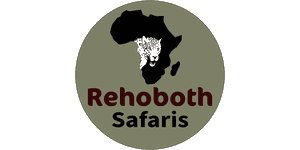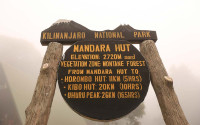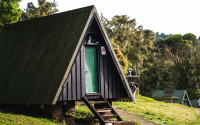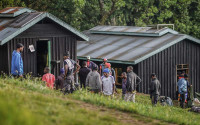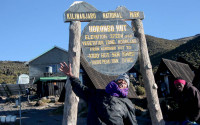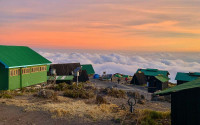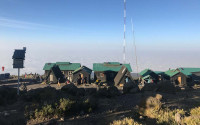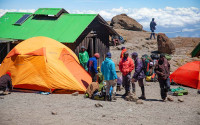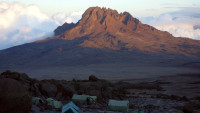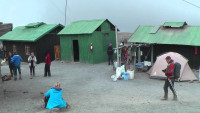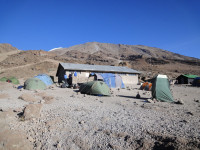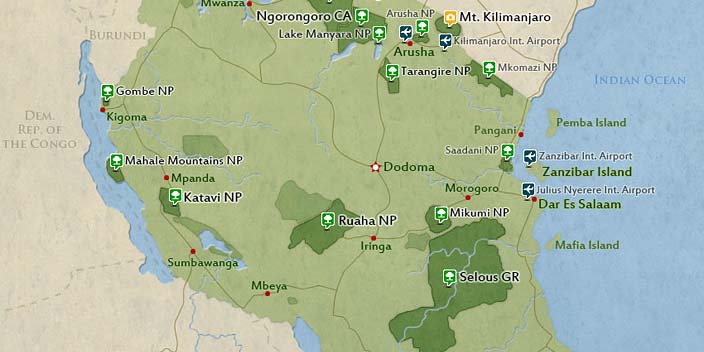
$1,969 pp (USD)
2 travelers on Start dateArrival
Arrival

Day 1
Arusha to Marangu Gate to Mandara Hut
Arusha to Marangu Gate to Mandara Hut
After an early breakfast, you'll be picked up from your hotel and driven to Marangu Gate, the starting point of the Marangu Route. The drive is approximately 3–4 hours, covering about 120 km. Along the way, you'll enjoy views of rural Tanzanian life-banana plantations, coffee farms, and glimpses of Mount Kilimanjaro on a clear day. On arrival, there's a check-in process with Kilimanjaro National Park authorities, porters will organize gear and supplies while you register in the climber’s logbook, this is a great time to use the facilities, fill water bottles, and take some pre-hike photos.
The trail starts in a lush rainforest zone. You’ll walk under a dense canopy, with moss-covered trees and a chance to spot colobus monkeys, birds, and colorful butterflies. After 3–5 hours of hiking, you’ll reach Mandara Hut, your first overnight stop. Your guide will give a briefing about the next day’s trek and check on your well-being. Nights can be chilly, so warm layers are essential.

Day 2
Mandara Hut to Horombo Hut
Mandara Hut to Horombo Hut
After a warm breakfast, you’ll pack up and begin your ascent toward Horombo Hut. Your body is still adjusting to the altitude, so you’ll move at a steady, comfortable pace-“pole pole” (slowly, slowly) remains the golden rule. The first part of the trail continues through montane forest, but after about an hour or so, you’ll begin to notice a dramatic change in the landscape. Trees thin out, giving way to giant heathers, low shrubs, and open views of the mountain-you are now entering the moorland zone.
Located on a plateau with sweeping views of both Mawenzi and Kibo, Horombo Hut is the largest overnight camp on the Marangu Route. The huts are dormitory-style, like Mandara, but more spacious. There's a central dining area and basic but functional toilet facilities.
You’ll likely arrive by mid-afternoon, with plenty of time to relax, journal, or take short acclimatization walks around camp.

Day 3
Horombo Hut-Acclimatization
Horombo Hut-Acclimatization
This day is not just for resting-it’s a planned acclimatization hike, which helps your body adjust to the increasing altitude and reduces the risk of Acute Mountain Sickness (AMS). The saying “climb high, sleep low” is key here: you’ll ascend to a higher elevation during the day and return to Horombo to sleep, allowing your body to adapt gradually. Benefits of the acclimatization day is, increases summit success rate, spending an extra night at this altitude gives your body more time to produce red blood cells and improve oxygen delivery, reduces risk of altitude sickness: Eases your body into the next major altitude jump to Kibo Hut and mental and physical recharge: Rest, food, and light exercise all help you stay strong and motivated.
Drink at least 3–4 liters of water. Keep moving lightly-don't spend the whole day in bed. Eat well even if your appetite is lower at altitude.
Watch for symptoms like headaches, nausea, or insomnia-these are common but should be monitored.
- Main Destination:
- Mount Kilimanjaro
- Accommodation:
- Horombo Hut
- Meals & Drinks:

Day 4
Horombo Hut to Kibo Hut
Horombo Hut to Kibo Hut
The day starts with a gentle but steady climb through the upper moorland. As you ascend, vegetation becomes sparser and the environment starts to feel more remote and barren. After a couple of hours, you’ll reach a vast, flat expanse called "The Saddle"-a high-altitude plateau between Mawenzi (5,149 m) and Kibo (5,895 m). This part of the hike can feel long and mentally challenging. The terrain is dry, dusty, and exposed-the sun is intense during the day, and the wind can be biting.
The air is thin and dry-many trekkers begin to feel the altitude more acutely here (headaches, fatigue, light nausea). Kibo Hut is more basic than previous camps: a simple stone structure with dormitory bunks and limited facilities.
You’ll eat an early, light dinner, guides will brief you on summit night-departure time (usually around midnight), what to wear, what to pack, and how to layer. Then it’s early to bed-even just 3–4 hours of sleep or rest can make a big difference for your summit stamina.
- Main Destination:
- Mount Kilimanjaro
- Accommodation:
- Kibo Hut
- Meals & Drinks:

Day 5
Kibo hut to Uhuru Peak to Horombo Hut
Kibo hut to Uhuru Peak to Horombo Hut
You’ll be woken around 11 PM, given tea, biscuits, and maybe some light snacks. Wearing full gear (headlamp, base layers, insulated jacket, gloves, gaiters, etc.), you begin the slow, dark ascent up the steep volcanic scree. After about 5–6 hours, you’ll reach Gilman’s Point (5,685 m) on the crater rim. Many trekkers cry here-it’s the first sign that you’re almost there. The views of the sun rising over the African plains and glaciers are awe-inspiring. Continue on to Stella Point (5,756 m) and finally to Uhuru Peak (5,895 m)-the highest point in Africa.
Congratulations! You’ve reached the summit of Mount Kilimanjaro. Celebrate with photos at the iconic Uhuru Peak sign. You’ll only stay 10–20 minutes-the altitude is harsh, and it’s vital to start descending soon.
You’ll reach Horombo Hut by mid-to-late afternoon. After a long, emotionally intense day, you’ll enjoy a hot meal and your best night’s sleep yet on the mountain.
- Main Destination:
- Mount Kilimanjaro
- Accommodation:
- Horombo Hut
- Meals & Drinks:

Day 6
Horombo hut to Marangu Gate to Arusha/Moshi
Horombo hut to Marangu Gate to Arusha/Moshi
You’ll wake up early, but compared to summit day, it feels relaxing and celebratory. After breakfast, you’ll pack your gear and begin the long descent down the same trail you came up on Days 1 and 2. After signing out of the Kilimanjaro National Park register, you’ll receive your certificate of completion: Green Certificate-if you reached Gilman’s or Stella Point. Gold Certificate-if you made it to Uhuru Peak. Celebrate with your guides and porters-some groups sing and dance to mark the achievement. It's customary (and appreciated) to tip your crew at this point if not already done.
After your goodbyes, you'll be driven back to your hotel in Moshi (45–60 minutes) or Arusha (2.5–3.5 hours). On the drive, you’ll feel a mix of pride, relief, and maybe a little fatigue-but also deep satisfaction.
- Main Destination:
- Mount Kilimanjaro
- Accommodation:
- No accommodation (End of tour)
- Meals & Drinks:

